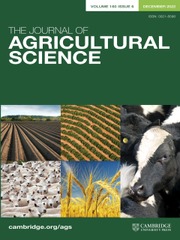No CrossRef data available.
Article contents
Comparison of four upscaling methods to drive instantaneous evapotranspiration to daily values for maize in two climatic regions in China
Published online by Cambridge University Press: 13 November 2024
Abstract
Accurately converting satellite instantaneous evapotranspiration (λETi) over time to daily evapotranspiration (λETd) is crucial for estimating regional evapotranspiration from remote sensing satellites, which plays an important role in effective water resource management. In this study, four upscaling methods based on the principle of energy balance, including the evaporative fraction method (Eva-f method), revised evaporative fraction method (R-Eva-f method), crop coefficient method (Kc-ET0 method) and direct canopy resistance method (Direct-rc method), were validated based on the measured data of the Bowen ratio energy balance system (BREB) in maize fields in northwestern (NW) and northeastern (NE) China (semi-arid and semi-humid continental climate regions) from 2021 to 2023. Results indicated that Eva-f and R-Eva-f methods were superior to Kc-ET0 and Direct-rc methods in both climatic regions and performed better between 10:00 and 11:00, with mean absolute errors (MAE) and coefficient of efficiency (ɛ) reaching <10 W/m2 and > 0.91, respectively. Comprehensive evaluation of the optimal upscaling time using global performance indicators (GPI) showed that the Eva-f method had the highest GPI of 0.59 at 12:00 for the NW, while the R-Eva-f method had the highest GPI of 1.18 at 11:00 for the NE. As a result, the Eva-f approach is recommended as the best way for upscaling evapotranspiration in NW, with 12:00 being the ideal upscaling time. The R-Eva-f method is the optimum upscaling method for the Northeast area, with an ideal upscaling time of 11:00. The comprehensive results of this study could be useful for converting λETi to λETd.
- Type
- Climate Change and Agriculture Research Paper
- Information
- Copyright
- Copyright © The Author(s), 2024. Published by Cambridge University Press



